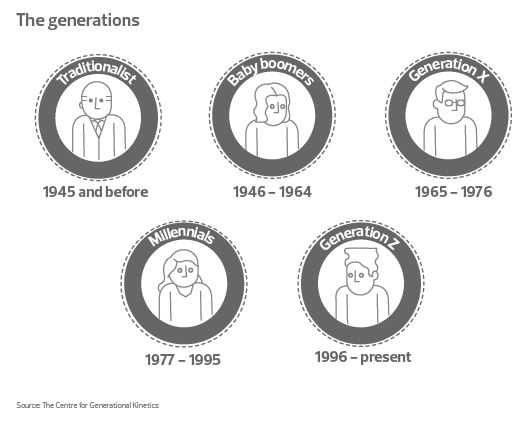
Your organisation is in an unprecedented situation. For the first time since the Industrial Revolution, five generations of employees now work side by side. This will bring new opportunities and new threats. Your future performance will depend on your ability to create a culture of collaboration, inclusion and understanding.
We are working longer than ever before. Improved living standards, deflating pension pots and increased legal protection against age discrimination have nudged the retirement age up. With people now working into their 70s and beyond, the age profile of your organisation has stretched. You must now manage five generations of employees, each with different values and motivations.
When managed in the right way, a five-generation workforce will give your organisation a competitive edge. Different generations bring different viewpoints. This diversity of ideas, experience and skillsets can broaden your knowledge base, help you better serve your customers and ultimately unlock growth.
Yet we know that some think these workforce changes will lead to more tension and conflict. It’s important to challenge these assumptions. Having five generations under one roof doesn’t have to create friction or management headaches. Success will depend on your ability to create a culture where everyone feels heard, valued and understood.

Mobilise your five-generation workforce
The arrival of the five-generation workforce requires a new approach to people management and incentivisation. The way you engage, develop, reward and mobilise your workforce must now adapt.
1. Work out your age profile
It’s critical that your management team gets a clear picture of the age profile of your organisation, and how this might change over the short and long term. This will ensure those at the top understand why your existing approach to people management may need to evolve. A regular workforce audit will reveal how many employees fall into each generational group, and emerging trends for how this could change. Remember that under the new General Data Protection Regulation you’ll need to tell your employees why you’re collecting their personal data and how this information will be stored.
2. Create an inclusive culture
One of the best ways to unlock the potential of your five-generation workforce is to create an inclusive and dynamic culture. Your CEO should send a clear message that your business works best when all voices are heard, understood and respected. Those at the top should make sure their behaviours don’t contradict this message. Your commitment to inclusion should be repeated on your website and intranet, as well as in your staff handbook, job descriptions and onboarding materials. This will give you the best chance of developing policies and reward programmes that foster positive attitudes among existing employees. It will also help you attract people who share these values.
3. Go beyond stereotypes
Baby Boomers want structured career paths, don’t they? And isn’t it true that Millennials prefer flexible opportunities, such as secondments and home working? The media has been quick to pigeonhole different generations. Don’t rely on these stereotypes – the only way you’ll find out what your workforce wants is to ask them. Run a regular employee engagement survey to understand what your people think about your organisation and what will motivate them to do a good job. Be prepared to hear more negatives than positives. You’re naturally going to be defensive, but it’s important you acknowledge what your employees have told you. Commit to act, whatever the results may be.
4. Find similarities and celebrate differences
The recent collision of stagnant wage growth and soaring living costs has toppled the long-held belief that each generation should have better opportunities than the one that came before. Tensions have begun to rise. Your organisation must find ways to strengthen inter-generational relationships. Consider introducing reverse mentoring to allow younger generations to share their ideas and perspectives with older employees. It’s also a good idea to introduce flexible development programmes to give your people the chance to progress and succeed, whatever their age and goals. Likewise, inclusive recognition and reward options will help you engage and incentivise all generations across your organisation.
5. Watch out for age discrimination
With five generations now in the labour market, the potential for age discrimination claims has increased. To protect your organisation, you must make sure your policies, procedures and practices don’t favour one generation while alienating others. You must also tackle unconscious bias. Generalisations and assumptions about generations – both positive and negative – can influence your decisions and lead to claims of age discrimination. Training is a useful way to encourage people to challenge their preconceptions. It will also help build awareness about risk areas.
